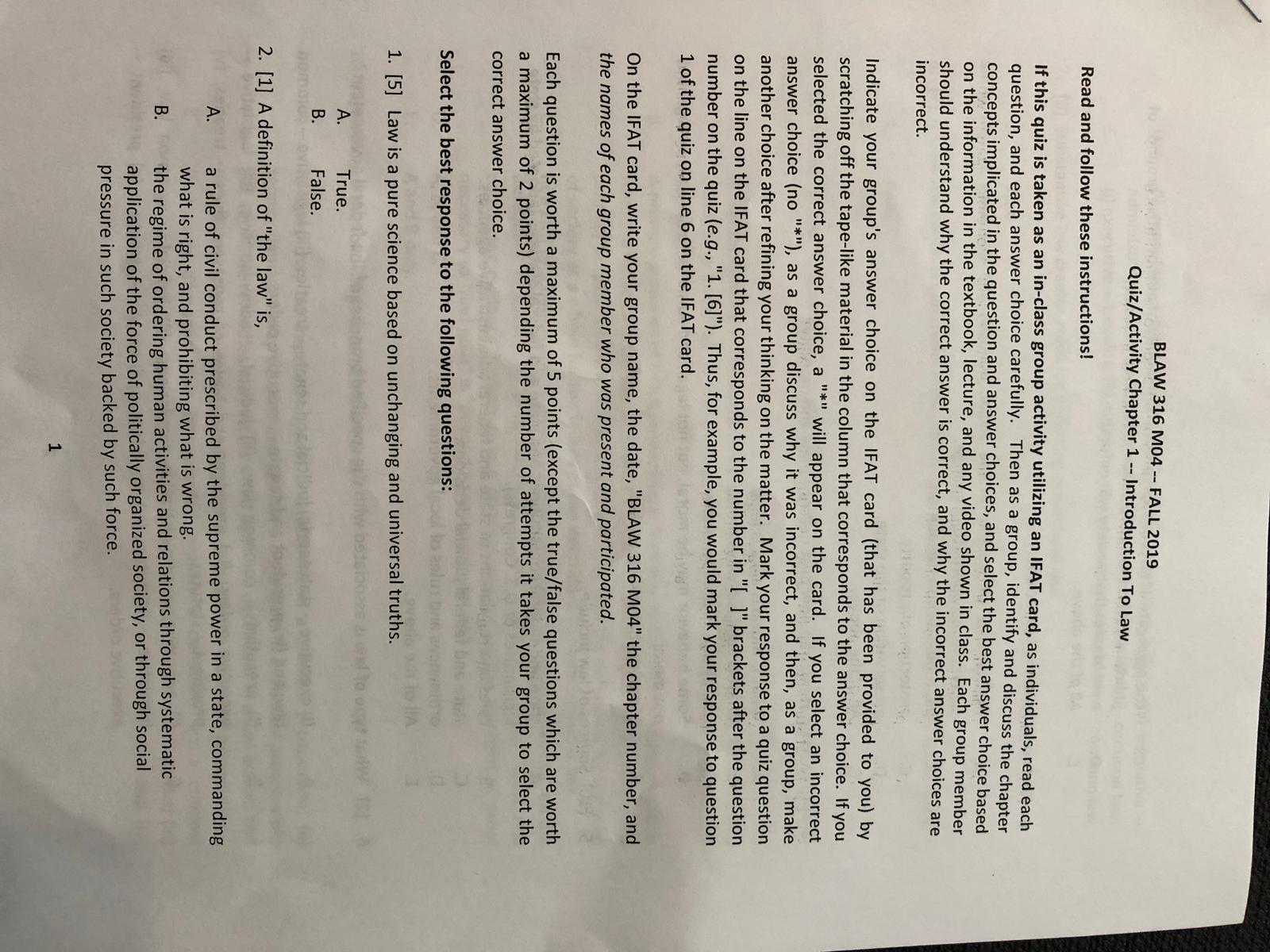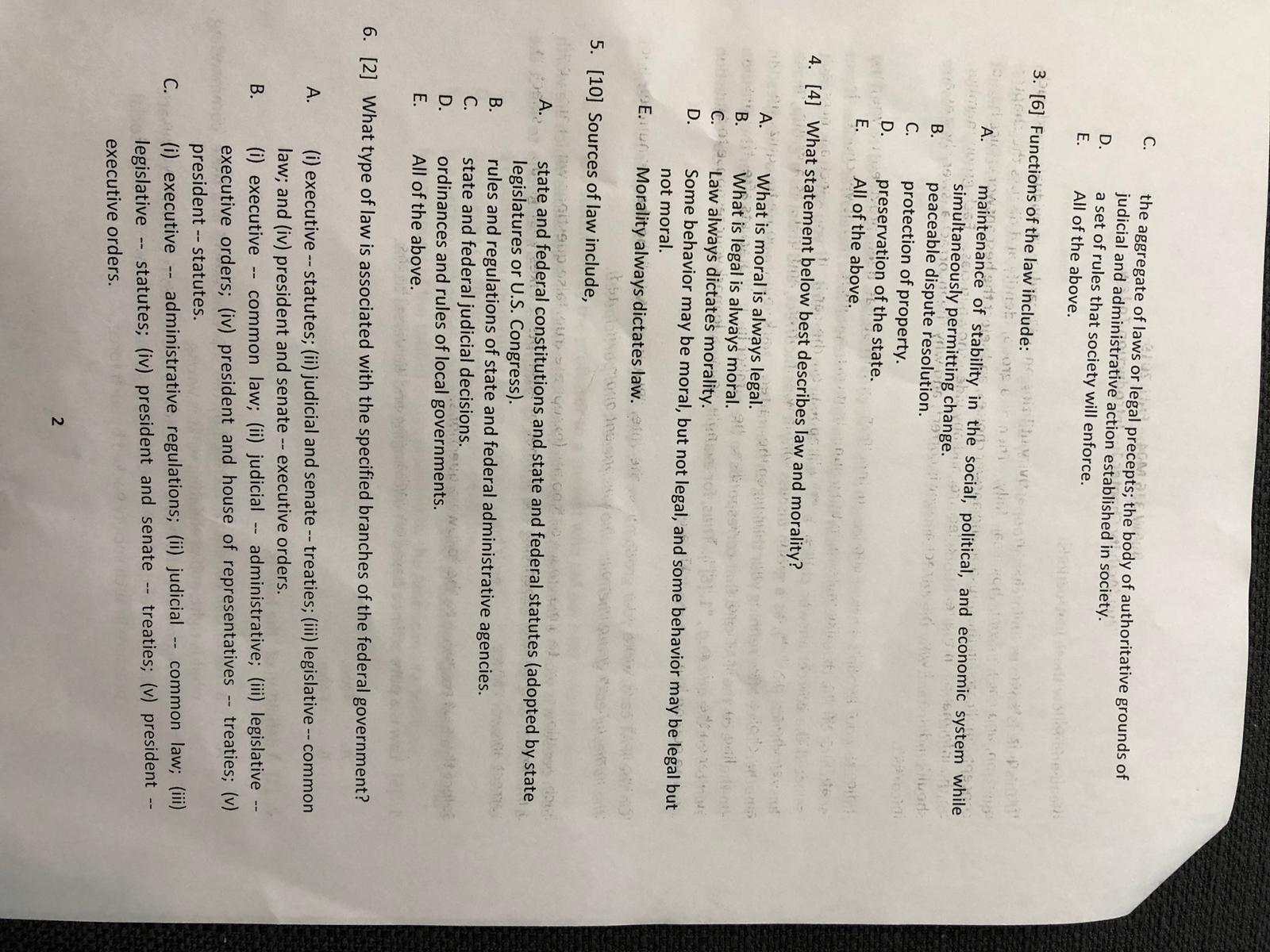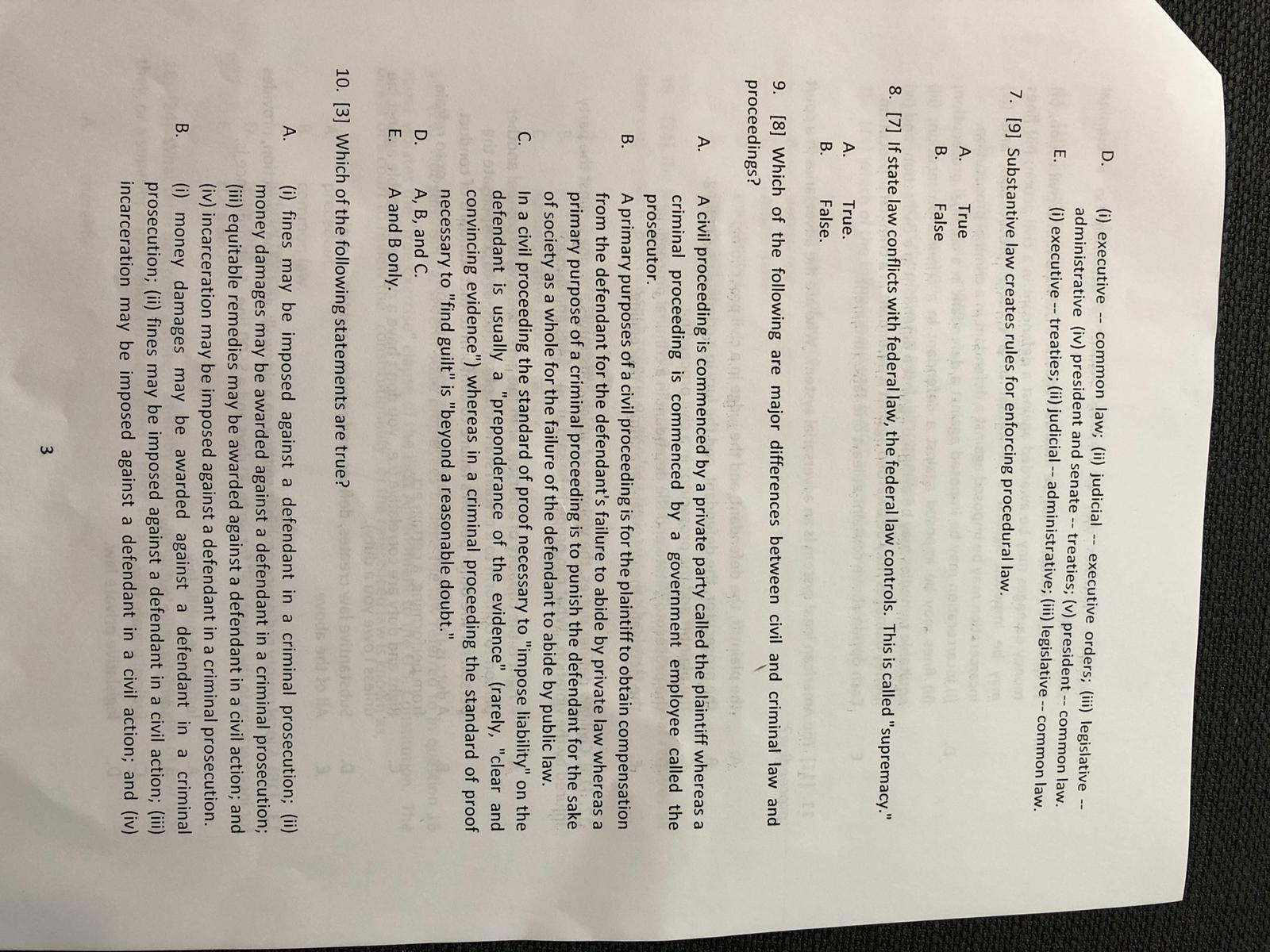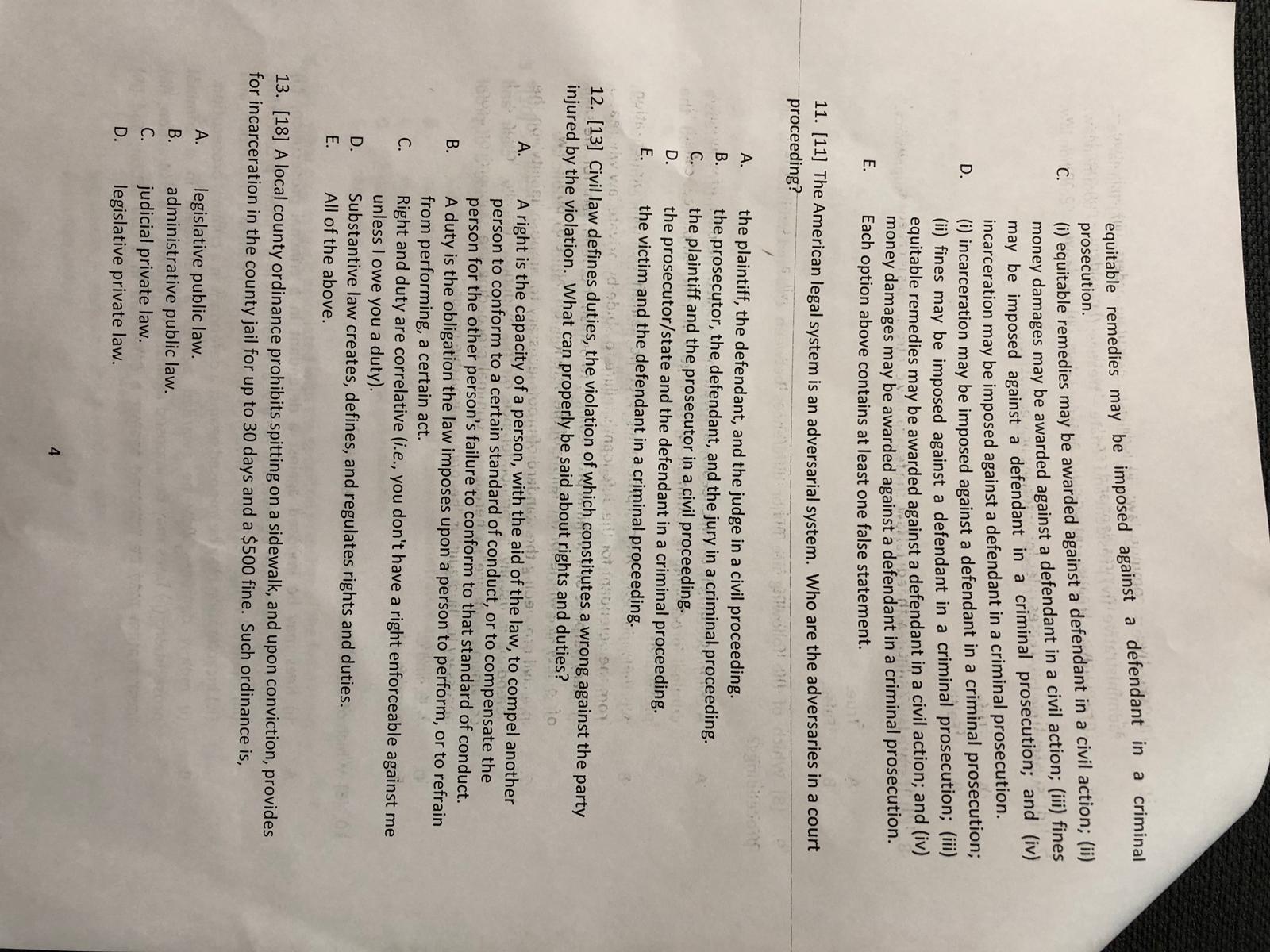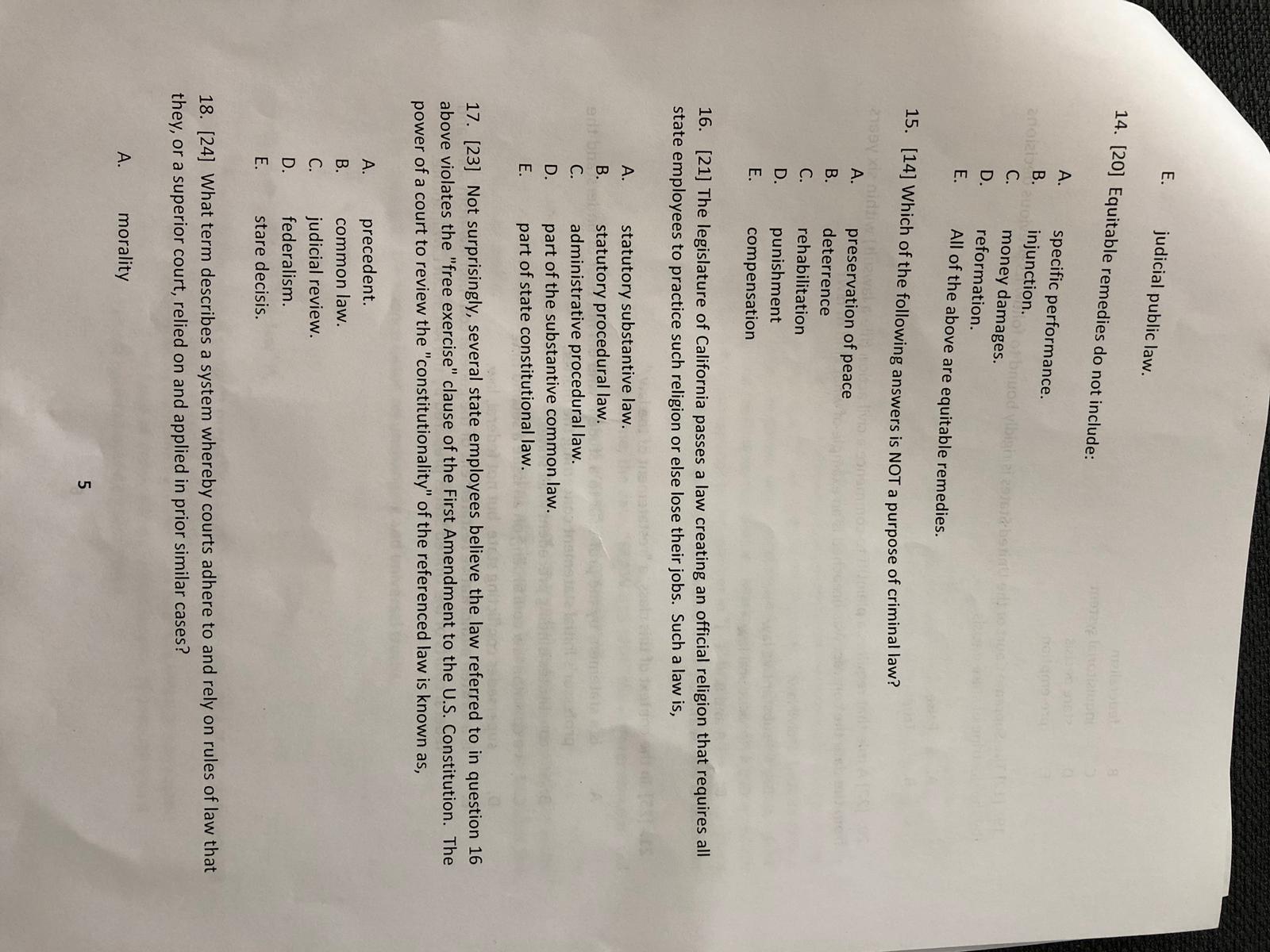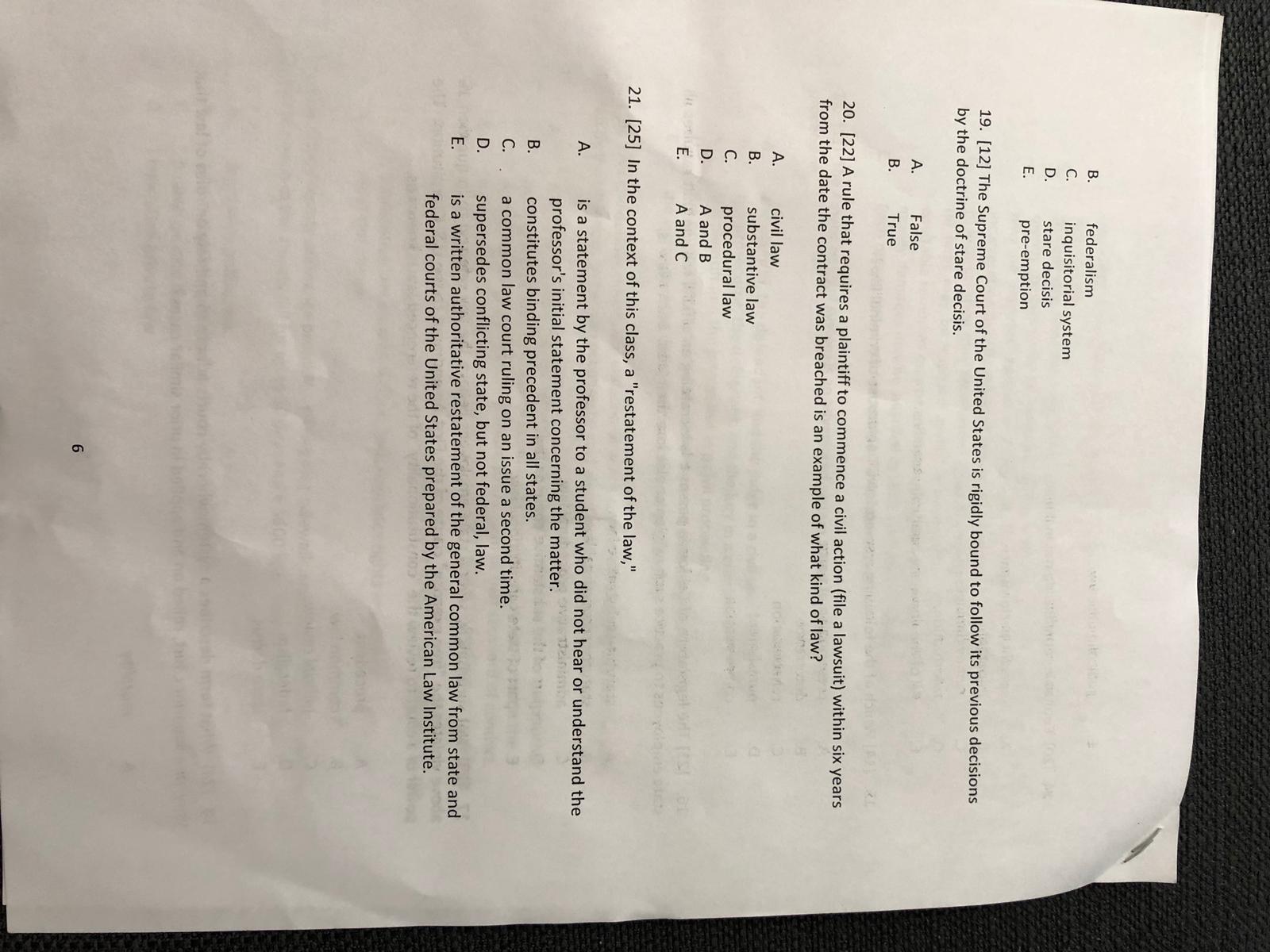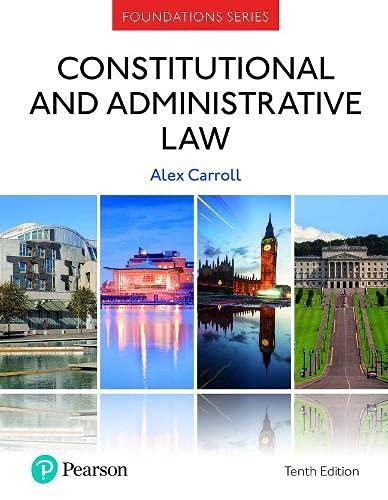BLAW 316 M04 -- FALL 2019 Quiz/Activity Chapter 1 -- Introduction To Law Read and follow these instructions! If this quiz is taken as an in-class group activity utilizing an IFAT card, as individuals, read each question, and each answer choice carefully. Then as a group, identify and discuss the chapter concepts implicated in the question and answer choices, and select the best answer choice based on the information in the textbook, lecture, and any video shown in class. Each group member should understand why the correct answer is correct, and why the incorrect answer choices are incorrect. Indicate your group's answer choice on the IFAT card (that has been provided to you) by scratching off the tape-like material in the column that corresponds to the answer choice. If you selected the correct answer choice, a "*" will appear on the card. If you select an incorrect answer choice (no "*"), as a group discuss why it was incorrect, and then, as a group, make another choice after refining your thinking on the matter. Mark your response to a quiz question on the line on the IFAT card that corresponds to the number in "[ ]" brackets after the question number on the quiz (e.g., "1. [6]"). Thus, for example, you would mark your response to question 1 of the quiz on line 6 on the IFAT card. On the IFAT card, write your group name, the date, "BLAW 316 M04" the chapter number, and the names of each group member who was present and participated. Each question is worth a maximum of 5 points (except the true/false questions which are worth a maximum of 2 points) depending the number of attempts it takes your group to select the correct answer choice. Select the best response to the following questions: 1. [5] Law is a pure science based on unchanging and universal truths. True. False . 2. [1] A definition of "the law" is, a rule of civil conduct prescribed by the supreme power in a state, commanding what is right, and prohibiting what is wrong. the regime of ordering human activities and relations through systematic application of the force of politically organized society, or through social pressure in such society backed by such force.the aggregate of laws or legal precepts; the body of authoritative grounds of Ow judicial and administrative action established in society. a set of rules that society will enforce. All of the above. 3. [6] Functions of the law include: vinson on time write si panel!' maintenance of stability in the social, political, and economic system while MU Ow simultaneously permitting change. peaceable dispute resolution. protection of property. preservation of the state. All of the above. 4. [4] What statement below best describes law and morality? What is moral is always legal.wang What is legal is always moral.to bail to not Law always dictates morality." Some behavior may be moral, but not legal, and some behavior may be legal but not moral. E. ) Morality always dictates law. is rising 5. [10] Sources of law include, A. state and federal constitutions and state and federal statutes (adopted by state legislatures or U.S. Congress). rules and regulations of state and federal administrative agencies. state and federal judicial decisions. ordinances and rules of local governments. All of the above. 6. [2] What type of law is associated with the specified branches of the federal government? (i) executive -- statutes; (ii) judicial and senate -- treaties; (iii) legislative -- common law; and (iv) president and senate -- executive orders. (i) executive -- common law; (ii) judicial -- administrative; (iii) legislative -- executive orders; (iv) president and house of representatives -- treaties; (v) president -- statutes. (i) executive -- administrative regulations; (ii) judicial -- common law; (iii) legislative -- statutes; (iv) president and senate -- treaties; (v) president -- executive orders. N(i) executive -- common law; (ii) judicial -- executive orders; (iii) legislative -- administrative (iv) president and senate -- treaties; (v) president -- common law. (i) executive -- treaties; (ii) judicial -- administrative; (iii) legislative -- common law. 7. [9] Substantive law creates rules for enforcing procedural law. I True False 8. [7] If state law conflicts with federal law, the federal law controls. This is called "supremacy." True. False. 9. [8] Which of the following are major differences between civil and criminal law and proceedings? A civil proceeding is commenced by a private party called the plaintiff whereas a criminal proceeding is commenced by a government employee called the prosecutor. A primary purposes of a civil proceeding is for the plaintiff to obtain compensation from the defendant for the defendant's failure to abide by private law whereas a primary purpose of a criminal proceeding is to punish the defendant for the sake of society as a whole for the failure of the defendant to abide by public law. In a civil proceeding the standard of proof necessary to "impose liability" on the defendant is usually a "preponderante of the evidence" (rarely, "clear and buboos convincing evidence") whereas in a criminal proceeding the standard of proof necessary to "find guilt" is "beyond a reasonable doubt." Ow A, B, and C. A and B only. 10. [3] Which of the following statements are true? oh seemso wel svilledue svods or to HA (i) fines may be imposed against a defendant in a criminal prosecution; (ii) money damages may be awarded against a defendant in a criminal prosecution; (iii) equitable remedies may be awarded against a defendant in a civil action; and (iv) incarceration may be imposed against a defendant in a criminal prosecution. (i) money damages may be awarded against a defendant in a criminal prosecution; (ii) fines may be imposed against a defendant in a civil action; (iii) incarceration may be imposed against a defendant in a civil action; and (iv)equitable remedies may be imposed against a defendant in a criminal prosecution. C (i) equitable remedies may be awarded against a defendant in a civil action; (ii) money damages may be awarded against a defendant in a civil action; (iii) fines may be imposed against a defendant in a criminal prosecution; and (iv) incarceration may be imposed against a defendant in a criminal prosecution. (i) incarceration may be imposed against a defendant in a criminal prosecution; (ii) fines may be imposed against a defendant in a criminal prosecution; (iii) equitable remedies may be awarded against a defendant in a civil action; and (iv) money damages may be awarded against a defendant in a criminal prosecution. Each option above contains at least one false statement. 11. [11] The American legal system is an adversarial system. Who are the adversaries in a court proceeding? MU the plaintiff, the defendant, and the judge in a civil proceeding. the prosecutor, the defendant, and the jury in a criminal proceeding. the plaintiff and the prosecutor in a civil proceeding. the prosecutor/state and the defendant in a criminal proceeding. the victim and the defendant in a criminal proceeding. 12. [13] Civil law defines duties, the violation of which constitutes a wrong against the party injured by the violation. What can properly be said about rights and duties? to bisba A right is the capacity of a person, with the aid of the law, to compel another person to conform to a certain standard of conduct, or to compensate the person for the other person's failure to conform to that standard of conduct. A duty is the obligation the law imposes upon a person to perform, or to refrain from performing, a certain act. Right and duty are correlative (i.e., you don't have a right enforceable against me unless I owe you a duty). Substantive law creates, defines, and regulates rights and duties. All of the above. 13. [18] A local county ordinance prohibits spitting on a sidewalk, and upon conviction, provides for incarceration in the county jail for up to 30 days and a $500 fine. Such ordinance is, legislative public law. administrative public law. judicial private law. legislative private law.judicial public law. 14. [20] Equitable remedies do not include: specific performance. andizio I muOw injunction. money damages. onuod vibighei zoterebinth erdt to reformation. All of the above are equitable remedies. 15. [14] Which of the following answers is NOT a purpose of criminal law? preservation of peace deterrence rehabilitation punishment compensation 16. [21] The legislature of California passes a law creating an official religion that requires all state employees to practice such religion or else lose their jobs. Such a law is, i muow statutory substantive law. statutory procedural law. administrative procedural law. part of the substantive common law. part of state constitutional law. 17. [23] Not surprisingly, several state employees believe the law referred to in question 16 above violates the "free exercise" clause of the First Amendment to the U.S. Constitution. The power of a court to review the "constitutionality" of the referenced law is known as, precedent. common law. judicial review. federalism. stare decisi 18. [24] What term describes a system whereby courts adhere to and rely on rules of law that they, or a superior court, relied on and applied in prior similar cases? morality LOfederalism inquisitorial system stare decisi pre-emption 19. [12] The Supreme Court of the United States is rigidly bound to follow its previous decisions by the doctrine of stare decisi i m False True 20. [22] A rule that requires a plaintiff to commence a civil action (file a lawsuit) within six years from the date the contract was breached is an example of what kind of law? MUOw civil law substantive law procedural law A and B A and C 21. [25] In the context of this class, a "restatement of the law," is a statement by the professor to a student who did not hear or understand the professor's initial statement concerning the matter. constitutes binding precedent in all states. a common law court ruling on an issue a second time. supersedes conflicting state, but not federal, law. is a written authoritative restatement of the general common law from state and federal courts of the United States prepared by the American Law Institute
